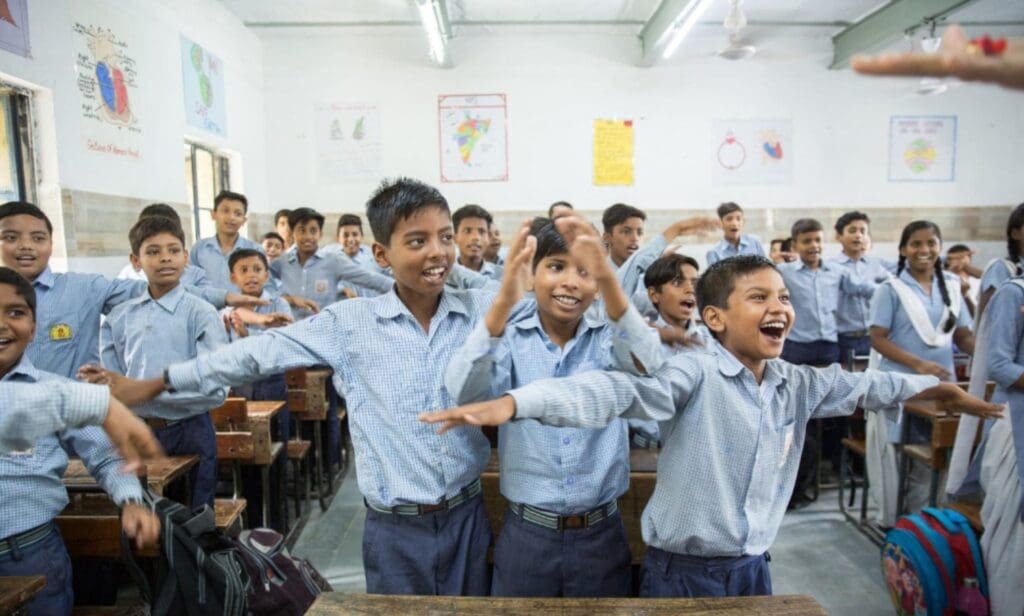
Imagine students in nursery school through Grade 8 developing the skills to cultivate greater happiness in life—from the inside out. In daily half-hour happiness classes, students learn from teachers and engage in games, storytelling, guided mindfulness practices, and role-playing. Each is encouraged to reflect on their feelings, thoughts, and behaviors, and how these impact their day-to-day lives, their families, society, and the natural environment.
This is the reality at 1,030 schools in India, where a government-sponsored happiness curriculum has reached 800,000 students since 2018. How are students and teachers responding? How do students define happiness as a result? What lessons can be gleaned from this sweeping effort that could inform its expansion and that of similar initiatives in the Global South?
Such are questions driving Jwalin Patel and Seema Nath, two researchers who were awarded a 2021 Mind & Life PEACE Grant to explore how students and teachers perceive the impact of the happiness curriculum. With social-emotional learning (SEL) competencies often defined in different ways in different contexts, the two seek to explore foundational questions: What does SEL mean to teachers who have taught the happiness classes and students who have participated? What does happiness look and feel like to them?
The two are among a growing number of recent Mind & Life grantees who seek to foster improved student well-being through research focused on mindful digital engagement, contemplative ecological education, the integration of mindfulness and social justice, and the use of contemplative practices to reduce racial bias among teachers.
According to a recent Gallup poll, unhappiness—in the form of increasing anger, stress, sadness, and worry—has been on the rise globally for more than a decade. While the reasons are many, one major contributor, the Gallup researchers suggest, are policy priorities, with global leaders more focused on gross domestic product (GDP) than how people are feeling. The emphasis on happiness education in India demonstrates growing concern related to mental health overall, with other countries, including Bhutan, Mexico, and Peru having experimented with similar initiatives. Various Indian educational policies (including the new National Education Policy) and thinkers have highlighted a broader vision for education emphasizing social emotional learning and well-being. The happiness curriculum was launched in the presence of the Dalai Lama, an outspoken advocate for ‘educating the heart,’ the subject of a 2018 Mind & Life Dialogue.
“It [the happiness curriculum] may be one of the largest—if not the largest—roll out of a curriculum of this nature in the Global South,” says Seema, a psychologist seeking to build more inclusive schools for diverse learners. Jwalin, Founder and President of the TIDE Foundation and author of a soon-to-be released book, Learning to Live Together Harmoniously, is focused on how holistic education can be integrated within public school systems.
The two are leading a mixed methods study that will explore how children and teachers understand happiness and their experiences of the curriculum. They’ll also be looking at the role of various components embedded within the intervention, including classroom pedagogy, contemplative and reflective practices, and project-based learning. Having just completed a pilot study within a co-ed government school, the team, in collaboration with Dream a Dream, is preparing for a longer qualitative study within six to eight government schools.
Focus group discussions with teachers and students will explore perceptions of qualities—such as pro-sociality, empathy, altruism, compassion, and ethics—that contribute to individual well-being among marginalized community members, while gaining a deeper understanding of the role of the happiness curriculum in nurturing these qualities. Through a photovoice component, students will be randomly selected to document their experiences of the happiness curriculum—in their school—with the aid of child friendly, disposable cameras. Each will produce an accompanying narrative of their imagery in writing or via a recorded interview. “Photovoice is a way of understanding how the curriculum is playing out in students’ day-to-day lives,” says Seema.
With a greater understanding of what students and teachers conceptualize as SEL, the researchers will then capture quantitative data through surveys of approximately 200 teachers and 5,000 students. The surveys will further explore teachers’ perceptions of SEL; their experiences of the curriculum; and key features of the program that contribute toward the development of SEL, happiness, and peace building. The student surveys seek to capture their experiences of the intervention; changes in their behavior and that of their teacher and peers; and the extent to which their relations with their peers, families, and community members are more empathic and compassionate.
While many impact studies of the happiness curriculum have been conducted, we hope to explore how teachers and children interpret and experience happiness. Through exploring teachers’ and children’s experiences and perceptions, Jwalin hopes to inform future studies about classroom pedagogies and how to achieve deeper impact at the school and district level.
Implicit in the research design is giving back to study participants. Communities of practice will be formed with participating teachers to share effective classroom practices and learn from one another. Through the course of the study, the research team will also organize a traveling exhibition of the student’s photo narratives to engage the wider community in conversation around what happiness is and how to cultivate it.
Jwalin and Seema wish to acknowledge the contributions of the Cell for Human Value and Transformative Learning (CHVTL)-State Council of Educational Research and Training’s (SCERT) Delhi, and Dream a Dream in pursuing their objectives through the Mind & Life PEACE grant.
Suggested Links:
- Learn more about Mind & Life grants.
- Read an essay by Mind & Life Steering Committee Member Robert Roeser on Education and the Heart of Social Change.
- Visit Education of the Heart, a multimedia website capturing presentations and discussions from the Mind & Life Institute’s 33rd Dialogue with the Dalai Lama held in Dharamsala, India in 2018.

